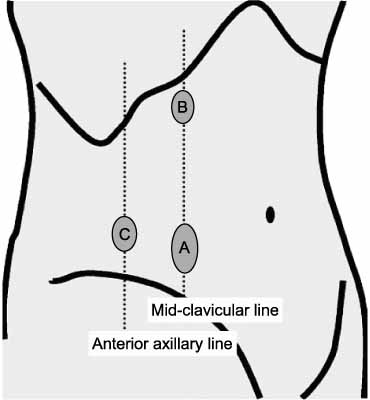Korean J Urol.
2007 Nov;48(11):1139-1142. 10.4111/kju.2007.48.11.1139.
Early Experience of Laparoscopic Nephropexy
- Affiliations
-
- 1Department of Urology and the Institute of Wonkwang Medical Science, Wonkwang University School of Medicine, Iksan, Korea. seraph@wonkwang.ac.kr
- KMID: 1997090
- DOI: http://doi.org/10.4111/kju.2007.48.11.1139
Abstract
-
PURPOSE: We evaluated the feasibility of laparoscopic nephropexy for treating patients with symptomatic nephroptosis according to our early experiences.
MATERIALS AND METHODS
Between June 2005 and June 2006, 3 patients with nephroptosis underwent laparoscopic nephropexy. They presented with long-standing flank pain. Nephroptosis was confirmed with performing supine and erect excretory urography(EU). The mean age of the 3 women was 40.7 years old, and their mean body mass index was 19.3kg/m2. The mean length of the nephroptosis was 7.5cm on EU. The operation was performed with a 3 trocar system through the transperitoneal approach. The renal capsule and parenchyme were fixed to the fascia of the quadratus lumborum muscle using 2-0 black silk.
RESULTS
Laparoscopic nephropexy was performed successfully in all patients. The mean operative time was 58.3 minutes. There was no operative complication and transfusion. Initiation of the oral intake and ambulation took place on postoperative day 1. The mean hospital stay was 5.7 days. Flank pain disappeared in 2 patients, and it was decreased in one patient for the 17.7 months of the mean follow-up. The mean length of the nephroptosis was 3.0cm on postoperative EU.
CONCLUSIONS
Laparoscopic nephropexy for treating symptomatic nephroptosis could be performed easily and safely with an excellent outcome.
Keyword
MeSH Terms
Figure
Reference
-
1. Urban DA, Clayman RV, Kerbl K, Figenshau RS, McDougall EM. Laparoscopic nephropexy for symptomatic nephroptosis: initial case report. J Endourol. 1993. 7:27–30.2. Bishoff JT, Kavoussi LR. Wein AJ, Kavoussi LR, Novick AC, Partin AW, Peters CA, editors. Laparoscopic surgery of the kidney. Campbell's urology. 2007. 8th ed. Philadelphia: Saunders;1759–1809.3. Plas E, Daha K, Riedl CR, Hubner WA, Pflüger H. Long-term followup after laparoscopic nephropexy for symptomatic nephroptosis. J Urol. 2001. 166:449–452.4. O'Reilly PH, Pollard AJ. Nephroptosis: a cause of renal pain and a potential cause of inaccurate split renal function determination. Br J Urol. 1988. 61:284–288.5. Moss SW. Floating kidneys: a century of nephroptosis and nephropexy. J Urol. 1997. 158:699–702.6. Marcovich R, Wolf JS Jr. Laparoscopy for the treatment of positional renal pain. Urology. 1998. 52:38–43.7. O'Dea MJ, Furlow WL. Nephropexy: fact or fiction? Urology. 1976. 8:9–12.8. Park HC, Cho JH. Experiences of modified nephropexy for nephroptosis. Korean J Urol. 1992. 33:510–513.9. Yang KH, Cho DH, Shin MS, Lee DW, Hwang TK. Nephropexy using percutaneous nephrostomy (PCN). Korean J Urol. 1994. 35:636–639.10. Rassweiler JJ, Frede T, Recker F, Stock C, Seemann O, Alken P. Retroperitoneal laparoscopic nephropexy. Urol Clin North Am. 2001. 28:137–144.11. Elashry OM, Nakada SY, McDougall EM, Clayman RV. Laparoscopic nephropexy: Washington University experience. J Urol. 1995. 154:1655–1659.12. Wright JL, Porter JR. Laparoscopic partial nephrectomy: comparison of transperitoneal and retroperitoneal approaches. J Urol. 2005. 174:841–845.13. Desai MM, Strzempkowski B, Matin SF, Steinberg AP, Ng C, Meraney AM, et al. Prospective randomized comparison of transperitoneal versus retroperitoneal laparoscopic radical nephrectomy. J Urol. 2005. 173:38–41.14. McDougall EM, Afane JS, Dunn MD, Collyer WC, Clayman RV. Laparoscopic nephropexy: long-term follow-up. Washington University experience. J Endourol. 2000. 14:247–250.15. Fornara P, Doehn C, Jocham D. Laparoscopic nephropexy: 3-year experience. J Urol. 1997. 158:1679–1683.16. Matsuda T, Uchida J, Ashida M, Mikami O. Laparoscopic nephropexy: a case report. Int J Urol. 1996. 3:397–400.17. Hubner WA, Schramek P, Pfluger H. Laparoscopic nephropexy. J Urol. 1994. 152:1184–1187.18. Sundaram CP, Grubb RL 3rd, Rehman J, Yan Y, Chen C, Landman J, et al. Laparoscopic pyeloplasty for secondary ureteropelvic junction obstruction. J Urol. 2003. 169:2037–2040.19. Matsui Y, Matsuta Y, Okubo K, Yoshimura K, Teri A, Arai Y. Laparoscopic nephropexy: treatment outcome and quality of life. Int J Urol. 2004. 11:1–6.
- Full Text Links
- Actions
-
Cited
- CITED
-
- Close
- Share
- Similar articles
-
- Experiences of modified nephropexy for nephroptosis
- Nephropexy by Posterior Vertical Incision
- Nephropexy Using Percutaneous Nephrostomy (PCN)
- A Clinical Analysis of 300 Case of Laparoscopic Cholecystectomy
- Laparoscopic extended right hemicolectomy with superiorto-inferior dissection: a mentee’s initial experience



